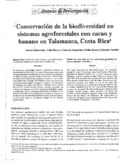| dc.contributor.author | Guiracocha, Giniva | es_ES |
| dc.contributor.author | Harvey, Celia A. | es_ES |
| dc.contributor.author | Somarriba, Eduardo | es_ES |
| dc.contributor.author | Krauss, Ulrike | es_ES |
| dc.contributor.author | Carrillo, Eduardo | es_ES |
| dc.contributor.other | CATIE - Centro Agronómico Tropical de Investigación y Enseñanza | |
| dc.date.accessioned | 2015-03-19T21:09:55Z | |
| dc.date.available | 2015-03-19T21:09:55Z | |
| dc.date.issued | 2001 | |
| dc.identifier | 420674 | es_ES |
| dc.identifier.issn | 1022-7482 | es_ES |
| dc.identifier.uri | https://repositorio.catie.ac.cr/handle/11554/5948 | |
| dc.description | 1 figura, 2 tablas, 9 ref. | es_ES |
| dc.description | Basado en Guiracocha, G. (2000). Conservación de la biodiversidad en los sistemas agroforestales cacaoteros y bananeros de Talamanca, Costa Rica. Tesis (Mag.Sc.) - CATIE, Turrialba (Costa Rica) | es_ES |
| dc.description.abstract | Se comparó la biodiversidad (árboles y mamíferos) presente en sistemas agroforestales (SAF) con cacao (Theobroma cacao) y con banano (Musa spp) y en bosques naturales en fincas de productores Bribris de Baja Talamanca, Limón, Costa Rica. Los SAF tuvieron menor diversidad, menor densidad de árboles y menos especies primarias que el bosque. Sin embargo, tuvieron una estructura multi-estratificada similar al bosque. La diversidad y abundancia de mamíferos fue similar en los SAF y el bosque, lo que sugiere que los SAF pueden proveer hábitat y recursos para ellos. La biodiversidad presente en los SAF proporciona beneficios (madera, frutos, leña, carne) y problemas (principalmente daños de mamíferos a los cultivos) a los indígenas de la región. En Talamanca, la conservación de mamíferos dependerá de un control racional de la cacería, así como de un manejo ecológico de los sistemas agroforestales. | es_ES |
| dc.description.abstract | The study compared the biodiversity (trees and mammals) present in cacao (Theobroma cacao) and banana (Musa spp) agroforestry systems (AFS), and natural forests in farms belonging to Bribri farmers, in Baja Talamanca, Limón, Costa Rica. The AFS had fewer tree species, lower tree densities and fewer primary forest species than the forest. Nevertheless their multi-strata structure was similar to that of the forest. The diversity and abundance of mammals in AFS was similar to that in forests, suggesting that the AFS may provide habitats and resources for mammals. The biodiversity present within the AFS provides benefits (timber, fruits, firewood and meat) and problems (mainly damage to adjacent crops) to the indigenous farmers in the region. In Talamanca, the conservation of biodiversity will depend on the rational control of hunting, as well as the ecological management of the AFS. | en_US |
| dc.language.iso | es | es_ES |
| dc.publisher | CATIE, Turrialba (Costa Rica) | es_ES |
| dc.relation.ispartof | Agroforestería en las Américas Volumen 8, número 30 (2001), páginas 7-11 | |
| dc.rights | info:eu-repo/semantics/openAccess | |
| dc.subject | THEOBROMA CACAO | es_ES |
| dc.subject.other | Sede Central | |
| dc.title | Conservación de la biodiversidad en sistemas agroforestales con cacao y banano en Talamanca, Costa Rica | es_ES |
| dc.title.alternative | Biodiversity conservation in cocoa and banana agroforestry systems in Talamanca, Costa Rica | es_ES |
| dc.type | Artículo | es_ES |
| dcterms.subject | MUSA (BANANOS) | |
| dcterms.subject | BIODIVERSIDAD | |
| dcterms.subject | CONSERVACION DE LA NATURALEZA | |
| dcterms.subject | HABITAT | |
| dcterms.subject | AGROFORESTERIA | |
| dcterms.subject | PLANTAS DE SOMBRA | |
| dcterms.subject | MAMIFEROS | |
| dcterms.subject | AGRICULTORES | |
| dcterms.subject | ESPECIES DOMINANTES | |
| dcterms.subject | COMPOSICION BOTANICA | |
| dcterms.subject | COSTA RICA | |


